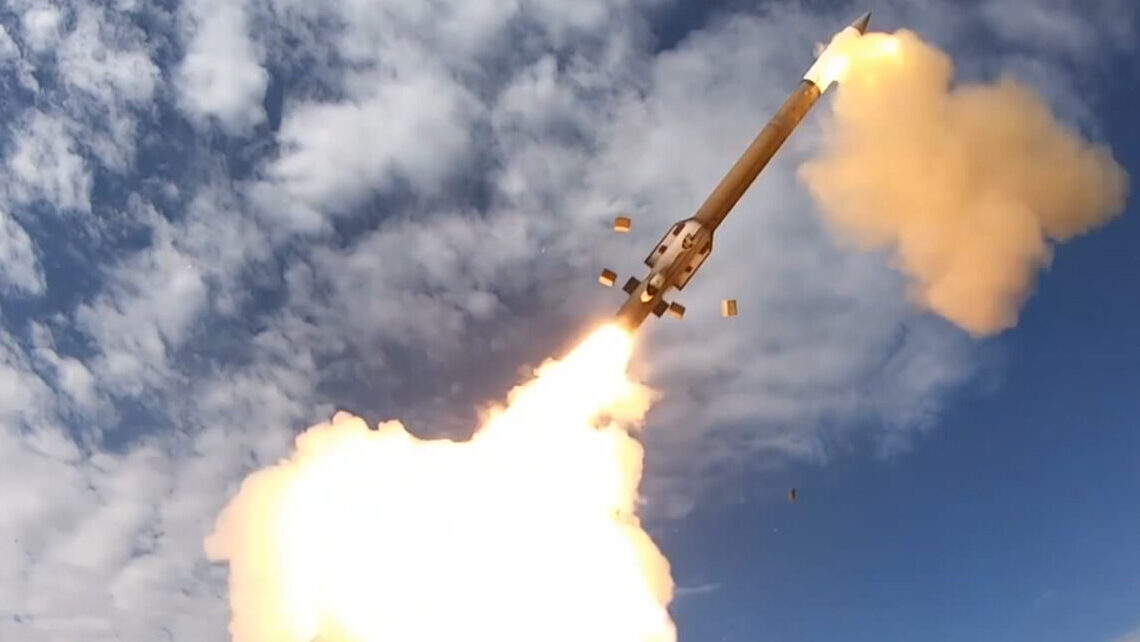
A Patriot Advanced Capability-3 (PAC-3) Cost Reduction Initiative (CRI) missile is launched during an Integrated Battle Command System (IBCS) flight test at White Sands Missile Range. (US Army)
WASHINGTON — After a delay while it gathered more information, the White House’s Office of Management and Budget has signed off on adding Patriot interceptors and Guided Multiple Launch Rocket System (GMLRS) to its planned list of multi-year contracts.
When the Biden Administration submitted its fiscal year 2024 budget request to Congress in March, it asked lawmakers for dollars for five multi-year munitions deals for Navy and Air Force programs. Similar requests for Patriot Advanced Capability (PAC)-3 missiles and GMLRS were expected to be included but Pentagon Comptroller Michael McCord said at the time that OMB placed those plans on a temporary hold, as it sought more information from the Army about the Lockheed Martin produced weapons.
On Tuesday, OMB notified Congress of numerous amendments to its FY24 budget request. Among those was the request to add Patriot interceptors and GMLRS to the list of programs aligned for multi-year contracts.
The document does not detail plans to adjust the administration’s procurement request for either munition line, which includes more than $1 billion for 5,064 GMLRS (890 fewer than in FY23), $1.2 billion for 110 PAC-3 Missile Segment Enhancement (MSE) weapons and $36 million for Patriot missile modifications.
Although multi-year contracts are traditionally reserved for larger ship and aircraft programs, the ongoing war inside Ukraine has highlighted a need to shore up US munition stockpiles and associated production lines. Those lessons helped orchestrate a provision in the FY23 defense authorization bill to provide the Pentagon with new authorities to ink such deals for a slew of programs including GMLRS and PAC-3. However, for any deal above the $500 million threshold, congressional appropriators must first sign off.
Accordingly, the Pentagon’s FY24 request asked for that permission for five munition lines uniquely aligned for the Indo-Pacific theater.
- Naval Strike Missile: $249.9 million for 103 missiles
- Standard Missile 6: $1.6 billion for 125 missiles
- AIM-120: $1.2 billion for 831 missiles
- LRASM: $1 billion for 118 missiles
- JASSM-ER: $1.8 billion for 550 missiles
At the time, McCord said Army programs were not included because the service was still working with OMB to get GMLRS and PAC-3 added to that list.
“I don’t want to make it sound like OMB is the bad guy here… . We still have homework to do,” McCord told reporters in mid-March. That homework, he said, was to show lawmakers the government will save money by entering into multi-year deals, and that a company’s suppliers can support the increased workload.
“One of the basic parts of homework for a multi-year is [showing] ‘Are there savings?’” McCord added. “In these cases, of things like GMLRS [being used in Ukraine], you might decide as a matter of public policy that you will be willing to enter into a multi-year without saving a lot of money because it was that important to you.”
Doug Bush, the head of Army acquisition, told reporters on March 28 that the service was trying to do just that — make the case that there could be “single digit” savings with those two multi-year deals while also providing industrial stability.
“The big prime contractors have the financial wherewithal to handle … the Army’s budget going up and down,” Bush said at the Global Force symposium in Huntsville, Ala. “But, right below that, second- and third-tier suppliers, they struggled greatly with… feast and famine approaches and that will be greatly strengthened by multi years.”
Aloha: Fixes ongoing, then Army’s new watercraft prototype is Hawaii bound for testing
“Everything that we can knock off that list we will do in the archipelago…because that allows us to do the tests in the environment that the vessel will operate in ultimately,” said Maj. Gen. Jered Helwig.


























